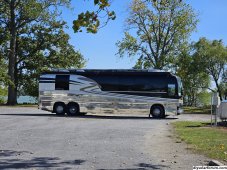I'm seeing a max difference of 7.7% run to run, but his four runs per "design" should hopefully mitigate some of the randomness. You're right though, it's not a perfect test which would be nearly impossible to conduct.
Do you have a source on that ford transit epa data? As a commercial vehicle, Transit's don't have to undergo mandatory epa testing, so Ford can claim anything they want with an asterisk saying *estimated.
Just from the drag equation, D = Cd * A * .5 * r * V^2 we can see that frontal area (which is effected by roof height) will increase the drag force and affect your mpg. 130 low has a frontal area of 46.41sf, 130 medium=55.95sf, 148 high-EL=62.33sf. Drag force from the air is thus 34% higher for the high roof compared to short low just from the frontal area change. That isn't the only drag the vehicle has to overcome, so the mpg won't be 34% worse, but it
definitely effects mpg.
Re: driving vs. solar. What I'm saying is that alternator charging, even by just idling the vehicle (like a generator), can be better than attaching solar panels to the roof with an inefficient roof rack design. Gary's same testing showed a very small mpg (0.1mpg) hit with his existing 315w panel. Using those numbers, it's only an extra 45 gallons of gas over the van's 200k mi life, which could only generate ~317kwh of energy through the alternator. The 315w panel should easily produce more usable power over its life than the vehicle fuel efficiency hit. What it all boils down to is that the details matter.
You're right that suitcase or deployable panels are the best from an MPG standpoint. They also have the benefit of being deployed in optimal locations to minimize shading. The drawback is that you can't generate power with them while driving, or on trips out and about around town. Just like every other choice in the van it's a decision of compromise and requirements. No single solution is going to be the optimal solution for everyone.
I've seen a couple interesting folding panel designs out there, this is the most interesting:
https://www.kickstarter.com/project...st-powerful-foldable-and-portable-solar-panel
One other solution I've seen that's very interesting (though not very efficient compared to standard panel) is this in development modular square panel design:
https://www.squaresolarinc.com/product/ Using these you could make a panel custom sized to fit any roof shape.





